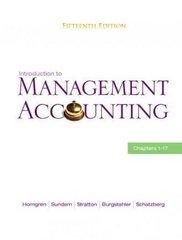Question
May please help me in solving this case study ASAP urgently before 12 PM ( middle east timing) I need the solution from CEO or
May please help me in solving this case study ASAP urgently before 12 PM ( middle east timing)
I need the solution from CEO or manager point view with step by step explanation.
Thanks in Advance
While we may be living in unprecedented times, past events provide insights and practices as pandemic recovery plans are developed. Consider these five elements of organizational decision-making: information gathering; strategy; combining long-term thinking with short-term actions; clear communication internally and externally; and a review of policies and processes to ensure the organization's preparedness for future crises.
Information gathering
The flow of high-quality information is more important than ever. A United States military framework for thinking about the external environment that has gained traction in the business world is VUCA: Volatility, Uncertainty, Complexity, and Ambiguity.
While these words seem similar in many respects, a key point of VUCA is that each of these terms describes a different situation that requires a specific response. Nathan Bennett, a professor with the Robinson College of Business at Georgia State University, and G. James Lemoine, an assistant professor in the Organization and Human Resources Department of the School of Management at the University at Buffalo, have written extensively on VUCA, and argue, "If VUCA is seen as general, unavoidable, and unsolvable, leaders will take no action and fail to solve an actual problem." Thus, diagnosis of the situation is a prerequisite to crafting a response.
They argue that volatility should be met with agility; uncertainty with information; complexity with restructuring (with internal operations reconfigured to address external complexities); and ambiguity with experimentation. Uncertainty in this sense refers not to scientific questions about the coronavirus, but to what effect the virus will have on the future. What new realities will it generate? What will recovery look like? How long will it take? What will a post-COVID world entail?
"Seek out new data sources and gather new perspectives."
Bennett and Lemoine recommend reaching out "to partners, customers, researchers, trade groups, and perhaps even competitors" in times of uncertainty, to understand the impact of this phenomenon. Seek out new data sources and gather new perspectives.
Here is how one CEO we've talked with builds in multiple perspectives to his decision-making. At his industrial products company, he has established bi-weekly meetings with his senior team focused on two questions: What do we know now that we did not know before? How can we use that information to make decisions? Each team member is responsible for research within their area: talking to big customers, participating in supplier forums and webinars, scouring competitor websites. At the meeting, team members share their findings and discuss the available data, what assumptions can be drawn from it, and insights to be leveraged. These discussions are then translated into action points.
Organizations should ensure internal decision-making processes incorporate conflicting points of view, in response to the broader perspective offered by his team's devil's advocate, one CEO shared that he took proposed across-the-board price cuts and implemented them in a much more nuanced way, with price decreases segmented by customer and channel.
Some strategies for decision-making in such circumstances:
- Managers need to step back and consider all options, both near term and long term. This is because gathering information in this environment can cause us to become "so focused on the immediate situation that we overlook the broader possibilities."
- Rather than focus on binary outcomes, which rarely play out, managers should consider the full spectrum of possible outcomes and assign probabilities to each.
- Keep in mind that "possibilities always exist." Even in the worst situations, there are opportunities and choices to be made.
Thinking about strategy
A clear sense of organizational direction is central to knowing what information is significant and avoiding information overload.
David J. Collis, the Thomas Henry Carroll Ford Foundation Adjunct Professor of Business Administration at Harvard Business School, and Michael G. Rukstad, the late senior research fellow at HBS as being a hierarchy that flows from the most enduring element, the corporate mission, through values, vision, strategy, and, ultimately, the implementation and monitoring of that strategy via tools such as balanced scorecards and key performance indicators (KPIs). The strategy includes an organization's objective, scope, and competitive advantage. In times of turmoil, CEOs should revisit their strategy and ask key questions: What is the organization's ultimate objective? In which directions (products, customers, geographies, vertical integration) will it go? In which directions will it not go? Finally, what does the organization do better or differently than othersin other words, what is our competitive advantage?
CASE STUDY WORKSHEET
Use this worksheet to evaluate the case study.
1.Identify the problem.
2.What are the person's choices?
a.
b.
c.
d.
e.
3.Gather information: What information should the person gather, that would be helpful to know before deciding?
a.
b.
c.
d.
4.Consider the outcome. What would be the results of the decision?
a.
b.
c.
d.
e,
5.Make the decision. What should the person do?
6.Evaluate your decision. Why do you think this is the best decision possible?
Step by Step Solution
There are 3 Steps involved in it
Step: 1

Get Instant Access to Expert-Tailored Solutions
See step-by-step solutions with expert insights and AI powered tools for academic success
Step: 2

Step: 3

Ace Your Homework with AI
Get the answers you need in no time with our AI-driven, step-by-step assistance
Get Started


